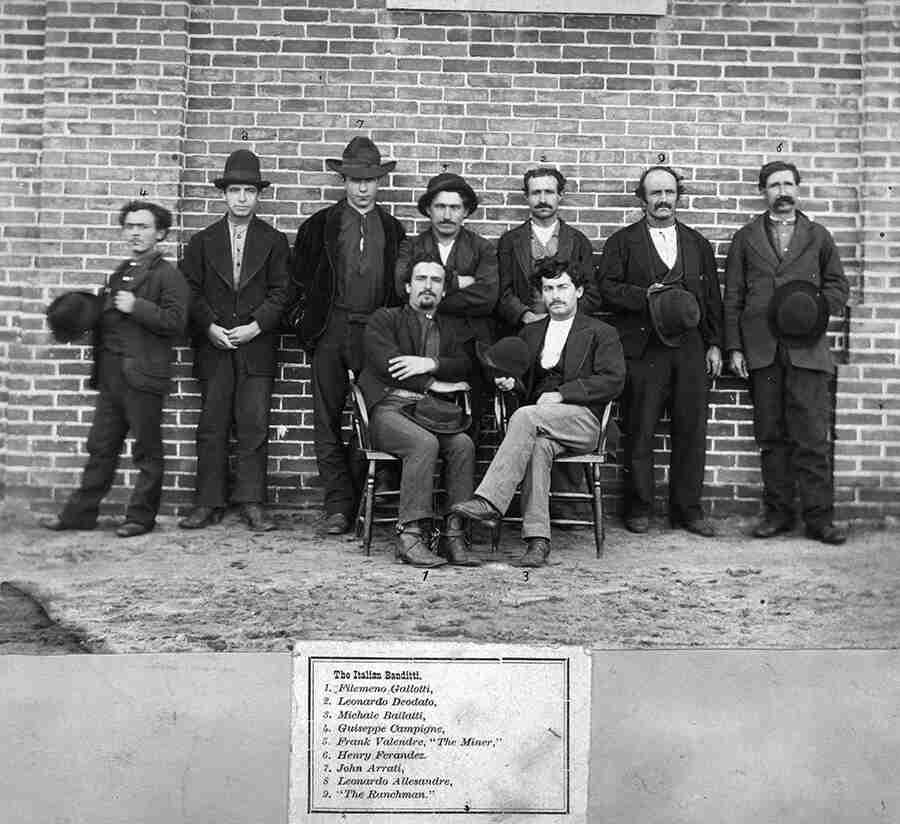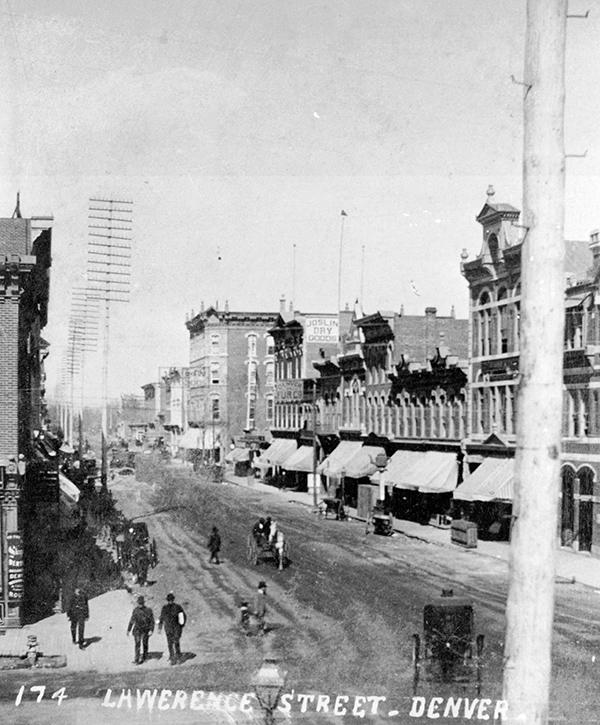Italian Murders of 1875
Full Article
In October 1875, the mutilated bodies of four Italian men were discovered in a house on Lawrence Street, shocking Denver citizens. Police eventually captured and charged nine members of a gang known only as the “Italian Banditti,” all of whom pled guilty to involvement in the crime. The so-called Italian Murders unleashed fear and outrage in the “Queen City,” as Denver was known at the time. Not only had the murderers been Italian immigrants, a group most Denverites perceived as mobsters and alcoholics, but they also had managed to escape the death penalty. This outcome ignited persistent tensions over capital punishment in Colorado, with the death penalty repealed most recently in 2020 after a decade-long reform effort.
Grisly Discovery
On October 20, 1875, Officer Sherman of the Denver police accompanied N. M. Robinson to a neighborhood of tenements on Lawrence Street. Investigating a horrible stench that had grown almost unbearable for residents, Robinson and Sherman searched for what they assumed was an animal carcass that had been left somewhere to rot. They were drawn to a small frame cottage at 634 Lawrence Street, where flies had gathered on the windows.
Upon entering the cottage, Sherman and Robinson discovered blood on the floor. The men followed the blood to a trapdoor in the kitchen, where the smell became so overwhelming that they had to retreat. When Sherman returned with deodorizing material, he ventured into the cellar, where he found the legs of two corpses protruding from under a rubbish heap. He immediately alerted the mayor and the coroner of his discovery. The coroner returned to 634 Lawrence Street with several men who had consented to bring the bodies up from the cellar. As the men started to move the pile of rubbish off the two bodies in the cellar, they discovered another two bodies. Along with the bodies, investigators found five dirk knives, three razors, and a hatchet, all stained with blood.
The murders caused a sensation; lurid reports soon appeared as far away as Chicago and New York. According to an October 26, 1875, article in the Chicago Tribune, the bodies were “swollen to almost bursting” and crawling with “swarms of filthy maggots.” They were also horribly disfigured, with their throats cut from ear to ear and stab wounds all over their breasts, abdomens, shoulders, and faces. Despite the state of decomposition, several neighbors were able to identify the bodies by the clothing, which was still intact. They were the bodies of Giuseppe “Uncle Joe” Pecorra, his two sons, and a young cousin, all Italian musicians who had been living in the house.
Investigation and Capture
Sheriff David J. Cook presumed that robbery was the most likely motive for the killings and began to gather information from neighbors. John Morris, a shoemaker who had identified the shoes on Giuseppe Pecorra’s body, mentioned that “Uncle Joe” had at one point been associated with two other men, Filomeno Gallotti and Michele Ballotti. Cook learned that Gallotti and Ballotti were members of a gang called the “Italian Banditti” or the “Italian Butchers,” several members of which had not been seen in Denver for roughly a week. Cook learned that three of the men had boarded a southbound train at Littleton a few days before the discovery of the bodies, presumably headed to Mexico, and he sent officers W. Frank Smith and R. Y. Force to pursue them.
Rumors that the murderers were Italians aggravated already tense ethnic relations in Denver. With the suspects still at large, a mob of citizens burned the house at 634 Lawrence Street because the police had not caught the murderers. Newspapers expressed these tensions, articles describing the suspects as “butchers,” “Italian Gorillas,” and “snarling mongrels.”
On October 26, 1875, Smith and Force arrived in Trinidad, where they learned that three men had arrived one day after the murders. Quickly tracking the men to an Italian-owned saloon, Smith and Force found Michele Ballotti, Silvestro Campagne, and Leonard Alessandri and brought them to the local jail for questioning. The men had fifty dollars’ worth of greenbacks and twenty dollars in gold pieces, which Smith suspected were stolen from the slain victims in Denver. Smith also found that Campagne and Alessandri wore bloodstained undershirts; Ballotti’s bloodstained undershirt was later found back at the saloon.
Frightened, Alessandri confessed that on Friday, October 15, he had played the harp while five other men committed the murders. He said that “Uncle Joe” and his older son were killed first, around noon, while the younger boys were out. Around one o’clock, the two younger boys returned home, and the gang killed them by cutting their throats. According to Alessandri, the murderers then took all four bodies to the cellar and stripped them of about $1,000 in greenbacks and gold pieces.
In Trinidad, Smith and Force had found three suspects. Alessandri’s testimony, which alleged that six men had committed the murders, led Smith and Force to expand their search to New Mexico in pursuit of the other three suspects. The officers crafted a ruse to track the fugitives. Smith dressed in a gentleman’s suit and pretended to be a wealthy sheep king from New Mexico, while Force—who had a darker complexion—dressed as a laborer and asked about the Italians, calling them his partners.
In early November, Smith and Force tracked the suspects to Taos, New Mexico. Word of a gun purchase involving gold pieces soon led to the arrests of Filomeno Gallotti and John Arratti. Acting on information from Arratti, the officers then went north to Red River to apprehend the final suspect, Henry Fernandez. The three men were taken back to Denver, where three additional members of the gang—Leonard Deodato, Frank Valendre, and a man known only as the Ranchman—were arrested at the end of the month.
Trial and Response
The Pecorra murder trial started in May 1876. All nine members of the “Italian Banditti” were tried for the murders, and all nine pled guilty to avoid execution. Arratti and Alessandri turned state witnesses, reducing their sentences to ten years each in exchange for their cooperation. Gallotti and Ballotti received life sentences, as did Frank Valendre. The rest of the men—Campagne, Fernandez, Deodato, and the Ranchman—were set free.
Public outrage followed the sentencing. Ethnic tensions had contributed to perceptions of Italian immigrants as drunken mobsters, and many in Denver believed that murder and crime would grow as Italians continued to come to the city. Several murders later occurred in Italian saloons in the 1890s and early 1900s, but in general residents’ fears were unfounded. Nevertheless, the Italian Murders certainly stoked these fears, and the fact that the Italian Banditti escaped the death penalty added fuel to the fire.
In addition, the seemingly light sentences handed down to the Banditti also contributed to Denver citizens’ sense that capital punishment was necessary to deter criminality. The Colorado Weekly Chieftain sharply criticized the sentences, stating that if men knew they could escape execution by pleading guilty, that would spell the end of capital punishment. If that were the case, the article warned, the “court of Judge Lynch” would start to be convened more frequently.






